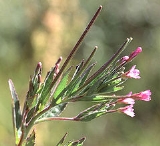
Epilobium ciliatum
Encyclopedia
Epilobium ciliatum is a species of willowherb
known by the common names Fringed Willowherb and American Willowherb. This plant is found in many parts of the world. It is native to much of North America and eastern Asia, and it is an introduced species
in much of Eurasia and Australia. It may be found in a great variety of habitats, including disturbed areas and roadsides.
This is a clumping perennial often exceeding one and a half meters in height. It has thickly veined lance-shaped leaves which may be up to 15 centimeters long toward the base of the plant. The foliage, stem, and inflorescence
are covered in bristly hairs and glands. The trumpet-shaped flowers have four petals which are so deeply notched they look like four pairs. They are white to light purple or pink with dark veining. The fruit is a narrow, hairy capsule up to 10 centimeters in length, and it may be held on a long stalk.
Three subspecies
are recognized as valid:
But it appears that E. ciliatum is actually a cryptic species complex
: the Rocky Mountain Willowherb (E. saximontanum) is sometimes included as yet another subspecies, while on the other hand it may well be that the three generally-recognized subspecies each consititute a distinct species. In this case, ssp. watsonii would perhaps use the name E. adenocaulon and at any rate include those populations, while E. glandulosum would include the populations referred to as E. bergianum. The other named populations would remain in E. ciliatum.
Epilobium
Epilobium is a genus in the family Onagraceae, containing about 160-200 species of flowering plants with a worldwide distribution. They are generally abundant in the subarctic, temperate and subantarctic regions, whereas in the subtropics and tropics they are restricted to the cool montane biomes,...
known by the common names Fringed Willowherb and American Willowherb. This plant is found in many parts of the world. It is native to much of North America and eastern Asia, and it is an introduced species
Introduced species
An introduced species — or neozoon, alien, exotic, non-indigenous, or non-native species, or simply an introduction, is a species living outside its indigenous or native distributional range, and has arrived in an ecosystem or plant community by human activity, either deliberate or accidental...
in much of Eurasia and Australia. It may be found in a great variety of habitats, including disturbed areas and roadsides.
This is a clumping perennial often exceeding one and a half meters in height. It has thickly veined lance-shaped leaves which may be up to 15 centimeters long toward the base of the plant. The foliage, stem, and inflorescence
Inflorescence
An inflorescence is a group or cluster of flowers arranged on a stem that is composed of a main branch or a complicated arrangement of branches. Strictly, it is the part of the shoot of seed plants where flowers are formed and which is accordingly modified...
are covered in bristly hairs and glands. The trumpet-shaped flowers have four petals which are so deeply notched they look like four pairs. They are white to light purple or pink with dark veining. The fruit is a narrow, hairy capsule up to 10 centimeters in length, and it may be held on a long stalk.
Three subspecies
Subspecies
Subspecies in biological classification, is either a taxonomic rank subordinate to species, ora taxonomic unit in that rank . A subspecies cannot be recognized in isolation: a species will either be recognized as having no subspecies at all or two or more, never just one...
are recognized as valid:
- Epilobium ciliatum ssp. ciliatum
- Epilobium ciliatum ssp. glandulosum (Lehm.) Hoch & P.H.Raven
- Epilobium ciliatum ssp. watsonii (Barbey) Hoch & P.H.Raven
But it appears that E. ciliatum is actually a cryptic species complex
Cryptic species complex
In biology, a cryptic species complex is a group of species which satisfy the biological definition of species—that is, they are reproductively isolated from each other—but whose morphology is very similar ....
: the Rocky Mountain Willowherb (E. saximontanum) is sometimes included as yet another subspecies, while on the other hand it may well be that the three generally-recognized subspecies each consititute a distinct species. In this case, ssp. watsonii would perhaps use the name E. adenocaulon and at any rate include those populations, while E. glandulosum would include the populations referred to as E. bergianum. The other named populations would remain in E. ciliatum.

